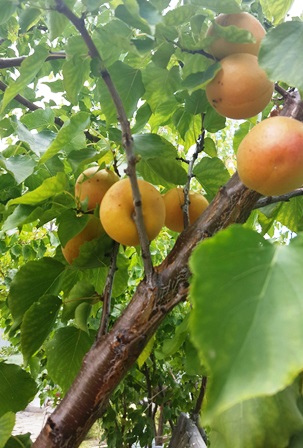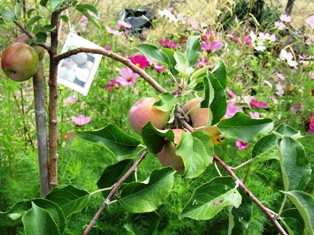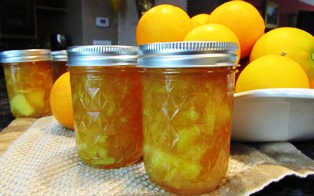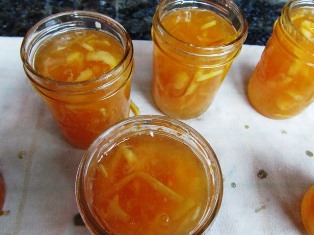California’s Farmers’ Markets Are in Full Swing
Nothing beats eating farm-to-table fresh vegetables, fruits, and berries. But what if you don’t have time or the room to grow wholesome, healthy foods yourself?
Our California farmers’ markets offer a dazzling variety of fruits, vegetables, berries, and nuts. These items are trucked or otherwise brought into our communities from local area farms and orchards.
Many fruits and vegetables are certified organic. That means the farmers and growers are registered and in compliance with state and local regulations designed to protect consumers and ensure food quality and safety.
Annually, California produces nearly half of the nation’s fruits, nuts, and vegetables, according to the California Department of Food and Agriculture. See http://www.cdfa.ca.gov/Statistics/
The San Joaquin Valley of central California has earned the moniker of the World’s Food Basket since its crops account for 12.8 percent of all agricultural products from California. https://www.cdfa.ca.gov/Statistics/PDFs/2015Report.pdf
California produces 88% of the nation’s strawberries
In fact, California leads the nation in production of figs, dates, plums, melons, nectarines, peaches (Clingstone and Freestone), pears (Bartlett), persimmons, raspberries, and apricots.
California apricots are available May through July
In the Golden State, you can find dozens of types of fruits offered at 350 farmers’ markets (some open all year long).
From the Pacific Coast Farmer’s Market Association, the following list (recapped below) reveals when these fruits are in season in California.
Apples: January-February; August-December
Apricots: May-July
Blackberries: June-September
Blueberries: May-August
Boysenberries: June-August
Cantaloupe: May-September
Cherries: April-June
Citrus: January-March; November-December
Dates: September-December
Figs: September-November
Grapes: August-November
Kiwi: January-April; October-December
Melons: June-September
Nectarines:May-September
Peaches: May-September
Pears: September-December
Persimmons: September-November
Plums: May-October
Pluots: May-September
Pomegranates: September-November
Prunes: May-September
Raspberries: May-October
Strawberries: February-November
Watermelon: July-September
* * *
If you enjoy reading about farmette topics (including gardening, beekeeping, and delicious recipes), check out my cozy mysteries A BEELINE TO MURDER and also THE MURDER OF A QUEEN BEE in the Henny Penny Farmette series (from Kensington Publishing).
Both area available through online retailers such as Amazon, Barnes & Noble, and Walmart as well as from traditional bookstores everywhere.

Now available in mass market paperback, this novel launched the Henny Penny Farmette series of mysteries
Growing Peaches in Northern California
What could be more sublime that eating a juicy, ripe peach freshly plucked from the tree? If you have space in your Northern California backyard or garden, consider planting one or more peach trees.
In the Bay Area, peaches are fairly easy to grow. Depending on the cultivar, they are heavy bearing. We planted a classic gold Elberta and some early-bearing Desert Gold peaches two years ago. Already, both trees are loaded with peaches.
I ate a Desert Gold peach off the tree today. It was ripe on one side and still a little crunchy on the other. Another week, and they’ll all be ready for a cobbler. The Elberta peaches will not be ripe until late July or early August.
Peaches are best eaten fresh, in my opinion. But they also freeze well or you can make them into jam, preserve them with spices, or blend up a batch of chutney or baby food. Your best bet is to plant peach trees during bare root season because they are cheaper and more plentiful then. Right now (second week of May), nurseries have replanted their bare root trees into pots.
One of my favorite nurseries in the Bay Area is Alden Lane Nursery in Livermore, California. The nursery carries hundreds of fruit and nut trees and thousands of roses. The oak trees on the property are 300 years old and one has a community of honeybees dwelling in the tree. It’s a great time to visit the nursery. For a list of offers, see http://www.aldenlane.com/media/softprogram.pdf.
Peaches need a lot of sunshine, high nitrogen fertilizer, and water to perform optimally. They also suffer from peach leaf curl, a fungus that can be easily treated with a fixed-copper spray. Dormant oil will control scale if they get it. The trees will live for 15 to 20 years.
Prolific producers, peaches need fruit thinning early on to yield larger fruit and avoid branch breakage. See the University of California’s Master Gardener program tip sheet for more information at http://homeorchard.ucanr.edu/Fruits_&_Nuts/Peach/.
If you love peaches, it’s not too late to plant a tree in your backyard for a bountiful crop of late spring/summer fruit.
California’s Farmers Markets Offer Fresh and Tantalizing Fruits and Berries
Eating fresh means growing it yourself or purchasing the food for your table direct from its source. California farmers’ markets offer a dazzling variety of fruits, vegetables, and nuts directly from local area farmettes, orchards, small and commercial farms, specialty growers, and ranchers.
Many fruits and vegetables are certified organic. That means the farmers and growers are registered and in compliance with state and local regulations designed to protect consumers and ensure food quality and safety.
Annually, California produces nearly half of the nation’s fruits, nuts, and vegetables, according to the California Department of Food and Agriculture. See http://www.cdfa.ca.gov/Statistics/
The San Joaquin Valley of central California has earned the moniker of the World’s Food Basket since its crops account for 12.8 percent of all agricultural products from California.
In fact, California leads the nation in production of figs, dates, plums, melons, nectarines, peaches (Clingstone and Freestone), pears (Bartlett), persimmons, raspberries, and apricots.
In the Golden State, you can find dozens of types of fruits offered at 350 farmers’ markets (some open all year long). For a list by county, see http://www.pcfma.com/markets.php.
From the Pacific Coast Farmer’s Market Association, the following list (recapped below) reveals when these fruits are in season in California.
Apples: January-February; August-December
Apricots: May-July
Blackberries: June-September
Blueberries: May-August
Boysenberries: June-August
Cantaloupe: May-September
Cherries: April-June
Citrus: January-March; November-December
Dates: September-December
Figs: September-November
Grapes: August-November
Kiwi: January-April; October-December
Melons: June-September
Nectarines:May-September
Peaches: May-September
Pears: September-December
Persimmons: September-November
Plums: May-October
Pluots: May-September
Pomegranates: September-November
Prunes: May-September
Raspberries: May-October
Strawberries: February-November
Watermelon: July-September
Certain Plants And Chickens Don’t Go Together
Chickens are curious creatures. Spend a hour watching them scratch, poke, and peck and you’ll see what I mean.
I’ve never lost a free-range chicken because of something it ate; but it seems as though they’ll eat anything. It got me thinking that a variety of plants commonly grown in landscapes and backyard gardens could make chickens ill if they ate the berries, nuts, or leaves of those plants.
The following represents a small sampling of common plants that could make your feathered friends sick or even poison them.
- Acorn
- Alfalfa
- Azalea
- Daffodil
- Eggplant
- Foxglove
- Hemlock
- Jasmine
- Jimson Weed
- Lamb’s Quarters
- Lantana
- Milkweed
- Nicotiana (tobacco)
- Oleander
- Oxalis
- Poison Ivy
- Poison Oak
- Pokeweed
- Pyracantha
- Red Maple
- Rhubarb
- Sweet Pea
- Tulip
- Wild Onion
- Wisteria
Chickens are foraging birds and have good natural instincts. They will taste a plant and if something isn’t right, they’ll likely leave it. If you allow them to forage for themselves in pasture, more often than not, they’ll eschew the poisonous plants in your garden or landscape for the rich diversity of what they find in open pastureland.
Easy Orange Marmalade
Who can resist the flavors of homemade jams? Whether it embellishes an appetizer of grilled fig and melted goat cheese or is spread upon a fat slice of fresh-baked bread, jam has power to elevate any meal to another level.
Using the seedless oranges growing on our farmette trees, I’m making marmalade. Marmalade made with the oranges ripening this time of year make great additions to holiday gift baskets. I like to add jars of honey, fresh tangerines, nuts, summer jams, and homemade treats.
RECIPE FOR ORANGE MARMALADE
Ingredients:
4 large oranges (preferably a seedless variety)
2 medium lemons
1/2 teaspoon butter (to reduce foaming)
1/8 teaspoon baking soda
6 Tablespoons dry classic pectin
5 1/2 cups sugar
Directions for Preparing the Jars and Canner:
Wash pint jars in the dishwasher or wash the jars and screw rings in hot soapy water, rinse, and drain upside down on paper towels.
Remove the wire rack from the canner and set aside; then, fill the canner half full of water and bring to a simmer.
Directions for Making the Fruit Mixture:
Wash the oranges and lemons.
Peel the fruit, using a vegetable peeler or a sharp paring knife. Discard any seeds and the pithiest parts of the inner peeling as the pith tastes bitter.
Cut the peeled skins into narrow strips.
Pour water into a saucepan.
Add baking soda and strips of peel.
Bring to boil and then reduce the heat, simmering for 20 minutes and stirring as needed.
Cut the fruit into thin quarters.
Add the fruit and juice to the saucepan of simmering peelings, cover, and allow everything to simmer for 10 minutes.
Remove 4 cups of the fruit/peeling/juice mixture and pour into a large saucepan (6 or 8 quart) or stock pot.
Stir in the pectin and add the butter and sugar, mixing well.
Bring to a roiling boil, stirring constantly, for a full minute and then remove from heat, skimming off any foam.
How to Can the Marmalade:
Ladle the fruit mixture into the warm, clean jars, leaving between 1/4 and 1/8 inch space from the top.
Wipe the jar rims before placing the jars on the wire rack of the canner.
Lower the wire rack of jars into the simmering water in the canner.
Make sure the jars are covered by 2 inches of water (add boiling water if necessary).
Cover with lid and boil for 15 to 20 minutes.
Turn off flame, remove the jars of marmalade, and set them onto a towel to cool.
Listen for the popping sound that signals the lids have sealed. Check lids for seal once the jars have cooled by pushing against the center of the lid. If it springs, the jar has not sealed and must be refrigerated. The marmalade will still be good to eat.
Drastic Measures to Keep the Woodpecker Away
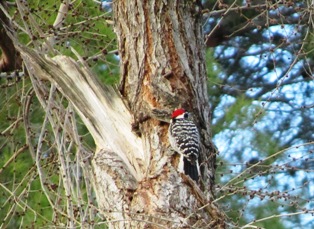
This lovely Nuttall’s Woodpecker has returned this year, perhaps to watch its offspring peck away at our roof strut
It’s been a week of rat-ta-tat-tat-tating and I’m growing wearing of hearing it. The woodpecker’s sound ordinarily doesn’t bother me, except I know it is pecking the foam, widening the hole of an exterior beam supporting the roof of this old house.
While my husband is away visiting relatives and I’m trying to keep the place tidy, the woodpecker isn’t going along with the plan. It is making a mess on the porch that rivals the squirrels’ messes when nuts are in season.
The bird has pecked wood shavings that fall into a pile on the porch. Worse, it is also pecking out the dry foam that we sprayed into the holes. Stopping the woodpecker’s assault against our beam forced me to take drastic measures.
When I heard the pecking this morning, I circled around the back of the house and sneaked along the side to catch the bird in the act. Seeing me, it took cover in the nearby elm tree.
From the bird’s size, I believe it to be either a female or a juvenile Nuttall’s woodpecker. We had one here last year that I photographed high in the pine tree. See http://www.allaboutbirds.org/guide/Nuttalls_Woodpecker/id
The solution, I think, might be a screen I found in a frame that clamps nicely over the two holes. Since securing the metal in place with screws, I haven’t heard a single rat-ta-tat-tat . . . not even in the nearby pine or the elm trees.
Nuts and Honey Add Lovely Flavor to Dried Fruit Tart
Flaky tarts piled high with fresh organic berries has always been for me a delightful way to end a summer meal. With the onset of winter now only eleven days away, I flip through my recipe files for something similar to those lovely summer tarts and hit upon an easy-to-make tart filled with dried fruits, nuts, and honey.
You can substitute or add other dried fruit (cranberries, figs, dates, and raisins, for example) to this tart, but I’ve found the best flavor comes from the dried peaches and apricots. They combine beautifully to create a richly flavorful dessert. A dollop of whipping cream on top adds a layer of decadence to this rich autumn tart.
Pastry Ingredients:
1 1/4 cup flour
1/4 cup sugar
1/2 cup unsalted butter (cut into pats or small pieces)
pinch of salt
1 large egg yolk
Directions for Pastry:
Combine pastry ingredients in a food processor with metal blade. Process until the mixture becomes a fine crumble. Add egg yolk and process into dough. Pastry should hold together, forming a ball.
Filling Ingredients:
3/4 cup white dessert wine
3/4 cup honey
18-20 dried apricots and/or peaches
1/2 teaspoon grated orange rind
1 cup blanched whole almonds
3 eggs
1 teaspoon good quality vanilla
2 Tablespoons unsalted butter
1 cup walnuts
Topping:
1 cup cream
1/4 teaspoon cinnamon
1 teaspoon of sugar
Directions for Toasted Almonds:
Preheat oven to 350 degrees Farenheit.
Toast blanched almonds on a baking sheet for 10 minutes. Remove and set aside. Keep oven on for baking the tart.
Directions for Tart Filling:
In a stainless steel pan, add the dried fruit with the orange rind.
Pour over the fruit and rind half the wine and 2 Tablespoons of honey.
Cook over low heat for 20 to 25 minutes until the fruit absorbs the liquid and plumps up, becoming soft and plaint.
In a bowl, combine eggs, honey, remaining wine, vanilla, and butter.
Beat in the walnuts and almonds.
In a springform pan, press the dough as thinly as possible over the bottom and up the sides of the pan. Drop the fruit onto the dough, spreading around over the bottom of the pastry. Pour in the nuts and egg mixture. Use a spatula to smooth the filling.
Bake the tart for 45 minutes on the middle rack of the oven.
Allow the tart to cool in its pan before removing and placing on a serving plate.
Whip cream until peaks form and fold in cinnamon and sugar. Put a dollop on top of each individual serving.
Serves 8.
 Facebook
Facebook Goodreads
Goodreads LinkedIn
LinkedIn Meera Lester
Meera Lester Twitter
Twitter








